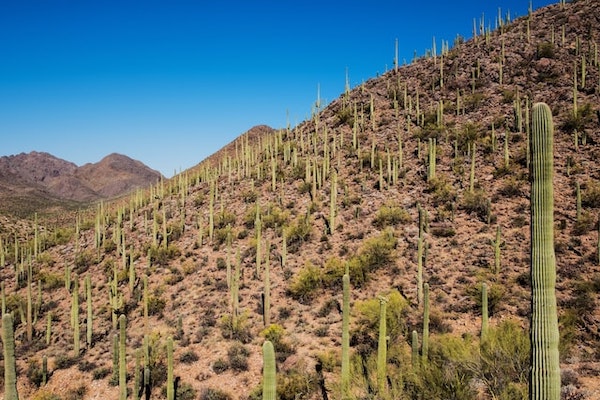
The Origins of Saguaro National Park

Listen to audio story here:
Great, you made the turn. See, it’s just that easy when you’re touring with Shaka Guide.
Now let’s talk more about Saguaro National Park itself. One of the strangest things about this park is, it’s got two completely different sides. This sometimes confuses people. You ask a local “Where’s Saguaro National Park?” and they’ll answer, “Which one?”
We’re heading into the west side of Saguaro National Park, known as the Tucson Mountain District, or TMD, for short. Or sometimes just Saguaro West.
So, okay, we’ve established that there’s two sides. But that brings up an interesting question: Why are there two, separate parts, of the same national park?
Well, it was actually the other side of the park, the Rincón Mountain District, aka Saguaro East, that came first. It had an expanse of stunning saguaros as far as the eye could see – they were so impressive that influential folks in Tucson, decided to preserve them. Saguaro East was made a national monument way back in 1933 by President Hoover. And, when word got out about the giant cacti, the dusty town of Tucson started raking in money hand over fist, as tourists like you and me flooded in.
But just a few decades later, scientists noticed something terrible: Most of the majestic saguaros were dying!
And nobody knew why.
Was it pollution? Some kind of pest or disease? No one had the answer, but everyone agreed that it wouldn’t be much good to have a Saguaro national monument … with no saguaros! Some predictions claimed that in a few decades, there wouldn’t be a single saguaro left in Rincón.
Luckily, though, the other side of Tucson had plenty of saguaros. They weren’t as tall, but they were tall enough. The Tucson Mountain District, where we’re headed now, was added in 1961 by President Kennedy. That way, if the East’s saguaros vanished, they had the West side as a backup.
And guess what? There's a happy ending, too: After lots of study, scientists determined the cause of the Rincón saguaros deaths was, well, just … old age. Today, if you visit Saguaro East, you’ll see hundreds of new, young saguaros, poking up from the shrubs and bushes. And in another few centuries, they’ll be as tall as the ones they’re replacing.
It wasn’t until 1994 that these combined areas got official National Park status. And as recently as 2021, even more land was added… so this is an ongoing, ever-changing process.
Speaking of ongoing, some native cultures have lived here for thousands of years, and incorporated the saguaro into their daily lives.
Long before we called these giant cacti “saguaros,” a name that comes from the Spanish, they were known as Hasan by the Tohono O’odham.
They’ve lived here for centuries, and have their own tribal lands and protected rights. They collected the fruit of the sacred hasan, and turned it into wine that was used in rituals. Now, I’ve read that when the Spanish arrived, they decided this practice was giving people a little too much fun, so they discouraged it. But the right to collect the fruit from this protected plant was recently returned, to those with tribal affiliation.
The indigenous people here have always treated these beautiful plants with respect. In just a little bit, I’ll tell you about a guy who wasn’t very nice to a saguaro… and paid a hefty price for it.
Want to visit? Explore Saguaro with our Shaka Guide Tour!
RELATED ARTICLES:
Know Before You Go, Shaka Guide's Saguaro National Park Tour
7 Amazing Hikes in Saguaro National Park
Shaka Guide's Saguaro National Park Tour Itinerary























 to fuel your ride
to fuel your ride 
